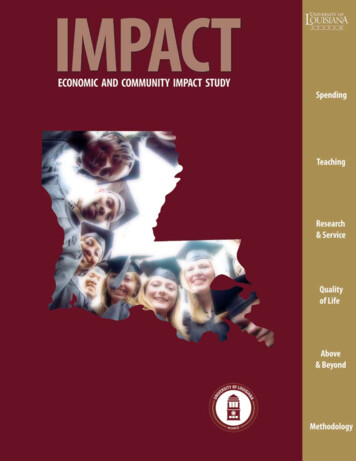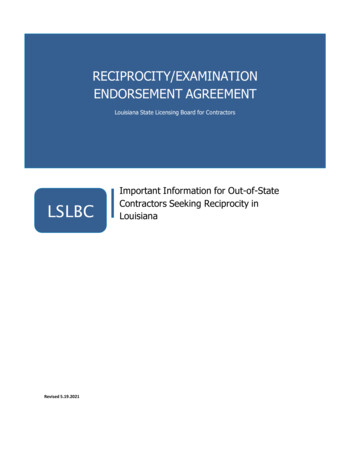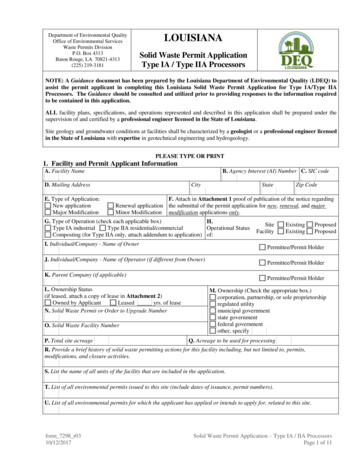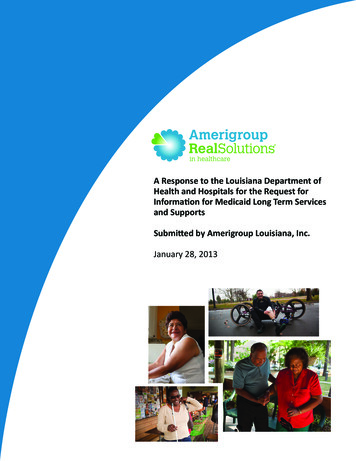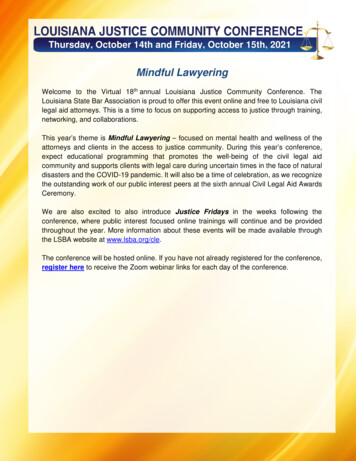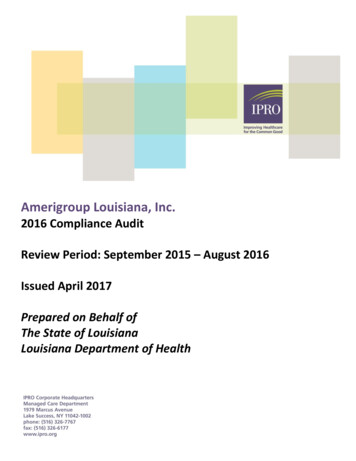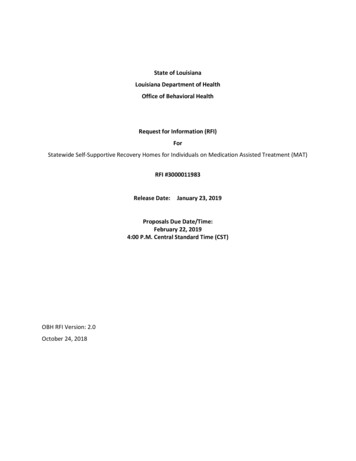
Transcription
State of LouisianaLouisiana Department of HealthOffice of Behavioral HealthRequest for Information (RFI)ForStatewide Self-Supportive Recovery Homes for Individuals on Medication Assisted Treatment (MAT)RFI #3000011983Release Date:January 23, 2019Proposals Due Date/Time:February 22, 20194:00 P.M. Central Standard Time (CST)OBH RFI Version: 2.0October 24, 2018
ContentsConfidentiality . 3Introduction . 4Office of Behavioral Health Mission . 4About Sober Living/Recovery Home Model . 4Opioid Epidemic Overview . 5Use of MAT and Availability of Housing . 9Purpose of the RFI . 9Scope . 10Self-Supportive Recovery Homes for Individuals on MAT RequirementsA. Compliance with SAMHSA Best Practices . 11B. Staffing Requirements . 11C. Reimbursement . 12D. Sustainability 12RFI Response . 12Outline . 12Proposer Inquiries . 14RFI Procedure . 14How to Deliver the Response . 14Abbreviations and Terminology . 15Regional Map . 16Sample Cover Page . 172
ConfidentialityThe designation of certain information as trade secrets and/or privileged, confidential, or proprietaryinformation shall only apply to the technical portions of your response to this Request for Information.Any response to this request marked as copyrighted or marked as privileged, confidential, or proprietaryin its entirety shall be subject to rejection without further consideration or recourse based on theprofessional opinions of Louisiana Department of Health (LDH) legal staff.Respondents should bear in mind that while trade secrets and other proprietary information submittedin conjunction with this RFI may not be subject to public disclosure, the submitting party must claimprotections at the time of submission. The following guidelines provide accurate instructions to markadequately certain information as privileged, confidential, or proprietary. The respondent shall clearly designate the part of the response that contains a trade secretand/or privileged or confidential proprietary information as “confidential” in order to claimprotection, if any, from disclosure. The respondent shall mark the cover sheet of the responsewith the following legend, specifying the section(s) of the response sought to be restricted inaccordance with the conditions of the legend:“The data contained in pages of this response have been submitted in confidence andcontain trade secrets and/or privileged or confidential information, and such data shall only bedisclosed for evaluation purposes. This restriction does not limit the State of Louisiana’s right touse or disclose data obtained from any source, including the proposer, without restrictions.” Further, to protect such data, respondents should identify and mark each page containing suchdata as “CONFIDENTIAL.” A watermark or footnote delineating each page containing such dataas “confidential” shall satisfy this requirement.Respondents must be prepared to defend the reasons why material should be held confidential. Ifanother respondent or entity seeks to review copies of a respondent’s confidential data, LDH shall notifythe owner of the asserted data of the request. If the owner of the asserted data does not want theinformation disclosed, it must take legal action as necessary to restrain LDH from releasing informationLDH believes to be public record.If the response contains confidential information, the respondent should submit a redacted copy of theresponse. Without the submission of a redacted copy, LDH may consider the entire response to bepublic record. When submitting the redacted copy, it should be clearly marked on the cover as a“REDACTED COPY.” The redacted copy should also state which sections or information have beenremoved.3
IntroductionOffice of Behavioral Health (OBH) MissionOBH’s mission is to work collaboratively with partners to develop and implement a comprehensive,integrated system of behavioral health and healthcare, social support, and prevention services thatpromote recovery and resilience for all citizens of Louisiana. OBH assures public behavioral healthservices are accessible, client focused, have a positive impact, are culturally and clinically competent,and are delivered in partnership with all stakeholders.About Sober Living/Recovery Home ModelSober living houses or recovery homes, more commonly called sober homes and recovery homes andmore rarely sober living environments, are facilities used by people recovering from a substance abusedisorder that serve as an interim environment between rehab and mainstream society.1,2,3 Sober LivingHomes grew out of a need to have safe and supportive places in which people could live while theywere vulnerable in early recovery. They are primarily meant to provide housing for people who havejust come out of rehab (or recovery centers) and need a place to live that is structured and supportingfor those in recovery. Sober living homes are safe, cost-effective, substance-free living environments forindividuals in recovery. They are also commonly known as sober houses, recovery homes, half-wayhouses or recovery residences. Some sober houses require residents to have already completedtreatment but this is not a prerequisite. Abstinence from alcohol and all illicit drug use is mandatory.Sober living homes usually offer a variety of services and amenities. Each house represents a remarkablyeffective and low cost method of preventing relapse. Numerous studies have shown that most peoplewho live in sober homes after attending treatment have low rates of relapse and are able to liveproductive lives. Sober living homes are realistic, cost-effective living environments for people inrecovery. Most residents at sober living homes have a private or semiprivate room. The homes usuallyinclude a kitchen, common areas and laundry accommodations. Some sober living homes have exerciseequipment, fitness areas, recreational space, pools and cookout areas. The homes may also be near anoutpatient treatment center or on the campus of a residential rehab facility. In other homes, counselorsor case managers visit on a regular basis to provide in-home services. Former residents and treatmentalumni may visit regularly to provide additional guidance and support.Sober living is a lifestyle characterized by healthy behaviors. It doesn’t include isolation. It includesbuilding relationships, supporting others and practicing healthy ways to overcome triggers. Establishinga sober lifestyle is difficult during the early stages of recovery. Individuals working a recovery programneed somewhere safe that they are able to go after treatment, a place where they’ll be free of triggersand surrounded by a comprehensive social support system.The services, rent, rules and living conditions at sober living homes vary from place to place. Somehomes are part of a behavioral health care system where residents live next to a rehabilitation clinic,participate in outpatient therapy and have access to the clinic’s recreational activities. Other homes arerun democratically and completely by residents with no oversight.Studies indicate that living in sober homes after inpatient treatment increases recovery rates, financialstrength and overall stability. An American Journal of Public Health study compared individuals who1Polcin, DL; Korcha, R; Bond, J; Galloway, G (2010). "What Did We Learn from Our Study on Sober Living Houses and Where Do We Go fromHere?". J Psychoactive Drugs. 42 (4): 425–33. doi:10.1080/02791072.2010.10400705. PMC 3057870. PMID 21305907.2 Wittman. "Affordable housing for people with alcohol and other drug problems". Contemporary Drug Problems. 20 (3): 541–609.3 Polcin, Douglas L.; Henderson, Diane McAllister (June 2008). "A Clean and Sober Place to Live: Philosophy, Structure, and PurportedTherapeutic Factors in Sober Living Houses". Journal of Psychoactive Drugs. 40 (2): 153–159. doi:10.1080/02791072.2008.10400625. PMC 2556949.4
lived in a sober living home to those who only received outpatient treatment or attended self-helpgroups. A study published in the Journal of Substance Abuse Treatment found sober living homeresidents experienced improvements in arrest rates, alcohol and drug use rates, and employment rates.The authors found evidence that 12-step program attendance and social support systems were keycomponents of recovery for residents. A variety of other studies have also found that sober living homesappear to be an effective component of the recovery process.Opioid Epidemic OverviewLouisiana is undergoing an opioid epidemic with a heavy burden of human, social and economicconsequences. Some notable consequences include the rising number of accidental drug overdoses, theincrease in cases of neonatal abstinence syndrome, the large number of individuals suffering from anaddiction to opioids, the ever present risk of becoming addicted to opioids, and other medicalconsequences like HIV and hepatitis C dissemination. In addition, but harder to quantify, the opioidepidemic is causing a disruption and erosion of family life with children most adversely affected; there isalso the loss of productive years of otherwise able men and women, the economic cost of treatment - orlack thereof, and the impact to the legal and law enforcement communities.The opioid epidemic includes both the opioid pain-relieving medications and illicit drugs like heroin thatare extracted from the opium producing “poppy” plant Papaver somniferum, the semi-synthetic andsynthetically produced opioids like fentanyl and like-molecules.4 In addition, there is growing misuse ofopioids in combination with other central nervous system depressants like benzodiazepines and alcohol.The opioid epidemic has been 30 years in the making and rose from multiple causes. For example, theover prescription of opioids for questionable conditions for which there was limited proven efficacy, themisguided marketing of these medications, past lax regulations and expectations from the medicalcommunity, the development of even more powerful opioids, and the growing illicit drug market, toname a few.5However, opioids have been important tools in the medical armamentarium for their efficacy in painmanagement, and other symptoms since antiquity.6 As such, opioids have been and continue to be alegitimate tool in the evolution of medicine, specifically palliative medicine and better end-oflife/hospice care. Palliative care, hospice providers and other specialists treat the sickest, mostvulnerable patients.7 Individuals with serious or life-threatening illness – such as cancer, AIDS, chronicobstructive pulmonary disease, severe trauma, end stage kidney disease, heart failure and acute heartmyocardial infarction, and sickle cell disease may also benefit from medically-indicated use of opioids.Some patients may benefit greatly from the timely, effective treatment of their pain and suffering, andother symptoms using opioid medications.4Pathan, H., & Williams, J. (2012). Basic opioid pharmacology: an update. British Journal of Pain, 6(1),11-16.5Kolodny, A., Courtwright, D.T., Hwang, C.S., Kreiner, P., Eadie, J.L., Clark, T.w., & Aleander, G.C. (2015).The prescription opioid and heroin crisis: a public health approach toan epidemic of addiction. Annualreview of public health, 36, 559-574.6Dilts SL Jr, Dilts SL (2005) Opioids: 138-156. In Frances RJ, Miller SI, Mack AH: Clinical textbook ofAddictive Disorders. Guilford Press. New Yok, NY.7Louisiana Mississippi Hospice and Palliative Care Organization: 2017 LA Hospice Report. Accessed10/24/18. Available at igures/5
National DataIn 2016, 63,632 drug overdose deaths occurred in the United States. The age-adjusted rate of overdosedeaths increased significantly by 21.5% from 2015 (16.3 per 100,000 people) to 2016 (19.8 per 100,000people). From a long-term perspective, the age-adjusted rate of drug overdose deaths in the UnitedStates in 2016 was more than three times the rate in 1999.8Opioids—prescription and illicit—are currently the main driver of drug overdose deaths. Opioids wereinvolved in 42,249 overdose deaths in 2016, which is 66.4% of all drug overdose deaths.9 Significantincreases in drug overdose death rates from 2015 to 2016 were detected in the Northeast, Midwest,and South Census Regions.10The overall opioid prescribing rate in the United States peaked and leveled off from 2010-2012 and hasbeen declining since 2012, but the amount of opioids in morphine milligram equivalents (MME)prescribed per person is still around three times higher than it was in 1999.11 MME is a way to calculatethe total amount of opioids, accounting for differences in opioid drug type and strength.There was a more than 19% reduction in annual prescribing rate from 2006 to 2017. The declines inopioid prescribing rates since 2012 and high-dose prescribing rates ( 90 MME) since 2008 suggest thathealthcare providers have become more cautious in their opioid prescribing practices.12State DataLouisiana is included in the South Census Region where drug overdose deaths have spiked substantially.For example, overdose deaths increased by 12.4% between 2014 and 2015, and 14.7% between 2015and 2016.13 In 2016, Louisiana reported 1,006 deaths with the most deaths occurring within the 21.1 52.0 age group. By comparison, Louisiana reported 875 deaths in 2015.14 There were 1,103 drugpoisoning deaths in 2017.12The national trend has trickled down to Louisiana where opioids are considered the main cause ofoverdose deaths. In 2016, 191 people died in Louisiana from an opioid prescription overdose. That is a25% increase in deaths from the previous year. The table below provides data on number of opioidanalgesic, fentanyl, methadone, and heroin deaths in Louisiana from 2014-2017.8Hedegaard H, Warner M, Miniño AM. Drug overdose deaths in the United States, 1999–2016. NCHSData Brief, no 294. Hyattsville, MD: National Center for Health Statistics. 2017.9Hedegaard H, Warner M, Miniño AM. Drug overdose deaths in the United States, 1999–2016. NCHSData Brief, no 294. Hyattsville, MD: National Center for Health Statistics. 2017.10Dilts SL Jr, Dilts SL (2005) Opioids: 138-156. In Frances RJ, Miller SI, Mack AH: Clinical textbook ofAddictive Disorders. Guilford Press. New Yok, NY.11Guy GP Jr., Zhang K, Bohm MK, et al. Vital Signs (20172): Changes in Opioid Prescribing in the UnitedStates, 2006-2015. MMWR Morbidity and Mortality Weekly Report 2017; 66:697-704. Accessed 9-10-18.Available at DOI: http://dx.doi.org/10.15585/mmwr.mm6626a412Guy GP Jr., Zhang K, Bohm MK, et al. Vital Signs (20172): Changes in Opioid Prescribing in the UnitedStates, 2006-2015. MMWR Morbidity and Mortality Weekly Report 2017; 66:697-704. Accessed 9-10-18.Available at DOI: http://dx.doi.org/10.15585/mmwr.mm6626a413Dilts SL Jr, Dilts SL (2005) Opioids: 138-156. In Frances RJ, Miller SI, Mack AH: Clinical textbook ofAddictive Disorders. Guilford Press. New Yok, NY.14Louisiana Department of Health, Office of Public Health, Bureau of Health Informatics. (Retrieved2018). Number of drug poisoning deaths by location [Data file] Retrieved from https://lodss.ldh.la.gov/6
Table 1: Number of Deaths by Specific Opioid Drugs Used, Louisiana 2014-2017Year2014 2015 2016Opioid Analgesic119 145191Natural and Semi-synthetic Analgesic90103110Synthetic Opioid Analgesic, 718Heroin108 127150*Data provided from the Louisiana Opioid Data and Surveillance System (LODSS)201723116515413610169Parish DataTo utilize existing state resources and avoid duplication of effort in assembling this data, the HOPECouncil is partnering with the Louisiana Opioid Surveillance Initiative (LOSI) in the Louisiana Departmentof Health (LDH). LOSI has received several federal grants to collect, analyze, and disseminate opioidrelated data and administer the Louisiana Opioid and Data Surveillance System (LODSS). LODSS is a webbased data dissemination tool that provides data visualizations and tables of opioid-related data at theparish and state level. Parish-level data included in this report come from LODSS.Opioid Prescriptions IssuedFor 2017, there was an average of 105 opioid prescriptions per 100 individuals in Louisiana. Using datafrom LODSS, LDH has identified the number of opioid prescriptions issued to residents by parish for2014-2017. For 2017, the five parishes with the highest numbers of prescriptions per 100 individuals arelisted below. Each of these parishes had more prescriptions issued than people residing in the parish.1. Rapides (210 prescriptions issued per 100 residents)2. Caddo (178 prescriptions issued per 100 residents)3. Evangeline (158 prescriptions issued per 100 residents)4. Lafayette (154 prescriptions issued per 100 residents)5. East Baton Rouge (144 prescriptions issued per 100 residents)A table containing the number of prescriptions issued to residents per 100 individuals for all 64 parishesfor 2014–2017 is included in Appendix B.Figure 1 Louisiana Opioid Prescriptions, 2017 Rates per 1007
Opioid Deaths by Parish of Occurrence and by Parish of ResidenceA total of 401 opioid-related deaths occurred in Louisiana during 2017. These deaths include Louisianaresidents as well as residents of other states and countries who died in a Louisiana parish. For deathslisted by parish of residence, the parishes to which the deaths are assigned are the parishes in which thedecedent maintained a residential address, and NOT the parish in which the decedent died. All deathsincluded in this section are ones in which the parish coroner determined the cause of death to bedirectly attributed to a drug poisoning, with opioids specifically listed in the secondary causes of deathfield.The five parishes by residence and occurrence with the greatest number of drug poisoning deaths fromopioids that occurred in 2017 are listed in the following table. Deaths listed for the five parishesrepresent 70% (258 of 366) deaths by parish of residence and 73% (294 of 401) of all deaths byoccurrence:Table 2: Opioid Overdose Deaths by Parish of Occurrence and by Parish of Residence, 2017Parish of ResidenceParish of Occurrence1. Jefferson - 1291. Jefferson - 1422. St. Tammany - 612. St. Tammany – 683. Washington - 273. Orleans - 354. Orleans - 244. Washington - 275. East Baton Rouge - 175. East Baton Rouge - 24A table containing number of opioid deaths by parish of residence for all 64 parishes from 2014-2017 isincluded in Appendix C. A table containing number of deaths by parish of occurrence for all 64 parishesfrom 2014-2017 is included in Appendix D.The map below provides a visual depiction of opioid overdose numbers across the state.Figure 2 Louisiana Opioid Involved Deaths, 2017 Rates per 100,0008
Use of MAT and Availability of HousingIn SFY 2018 79,918 MAT prescriptions filled for Medicaid recipients (MAT Buprenorphine, Suboxone,Bunavail, Zubsolv, Probuphine, Naltrexone, Vivitrol). Medicaid paid 25,686,680.19 for MATprescriptions. Data source Medicaid data warehouse.There were 11,839 unduplicated Medicaid Recipients on those 79,918 MAT prescriptions filled duringSFY 2018.The Office of Behavioral Health is not aware of any organizations that provide statewide housingopportunities for individuals taking MAT utilizing evidenced based practices.Purpose of the RFILDH-OBH is committed to offering inclusive housing opportunities for individuals with OUD that requireMAT. Currently there are an unspecified number of sober living and/or recovery homes operatingstatewide. However, OBH is not familiar with any of these homes that may provide housing toindividuals diagnosed with OUD and who are prescribed some form of MAT in an effort to abstain fromopioid addiction. LDH-OBH is committed to offering a choice of providers to individuals seeking thisform of specialized care. LDH-OBH issues this Request for Information (RFI) to gauge the interest andcapabilities of provider organizations, agencies and or groups to provide the following: OBH will expand recovery homes by funding three Peers/Outreach Workers. Two OutreachWorkers will work with the Department of Public Safety and Corrections (DPSC) re-entrypopulation, with a focus on persons with OUD transitioning from incarceration to thecommunity. Re-entry centers will be offered face to face workshops on OUD and MAT. OneOutreach Worker will serve as a peer trainer to target sober living homes and provideworkshops/trainings to homes statewide on MAT. One hundred sober living home residentsstatewide will be trained on MAT per year, totaling 200 recovery home residents over the twoyear grant period. This training will encourage a paradigm shift away from abstinence basedhousing and toward non-discrimination against persons on MAT. In addition, the Outreach Workers will expand the number of sober living homes statewide by10 recovery homes per year, totaling 20 recovery houses over the two-year grant. Each homewill have at least four residents with OUD who are prescribed MAT each (totaling 80 residents).LDH-OBH issues this Request for Information (RFI) to gauge the interest and capabilities of providerorganizations or groups to provide the following across the state:1. Safe, democratically operated, drug free living environments that are conducive to longterm recovery for individuals suffering from OUDs.2. Allow residents access to various forms of MAT without the fear of isolation and/ordiscrimination.3. Within a two year period, develop 20 new sober living houses statewide in Louisiana forindividuals with OUD that require MAT to serve 80 individuals per year.4. Outreach Workers who will work with DPSC re-entry population, expand the number ofsober living homes statewide and provide workshops/trainings to homes on MAT andNaloxone.5. Individual and group educational sessions to educate sober living housing residents on MATand Naloxone.In addition, the organization must have the ability to:9
1.2.3.4.Appropriately bill and document to support billing for services;Collect and report data;Provide professional development and coaching of the staff; andParticipate in training courses and conferences throughout the year.This document describes the basic components of the current system and requests informationregarding a provider’s thoughts, interest and ability to meet the needs of providing housing forLouisiana’s citizens diagnosed with OUDs and on a MAT regiment.OBH is requesting proposals include a clear statement indicating an understanding of the unique role ofrecovery homes. Proposals must include an outline indicating the special training and supervisoryneeds when employing non-mental health professionals to provide support services. The proposalshould include: A comprehensive peer training plan inclusive of the Peer Workers Core Competencies, asoutlined by the Substance Abuse and Mental Health Services Administration (SAMHSA)located at: s campaigns/brss tacs/corecompetencies.pdf. These include: recovery-oriented, person-centered, voluntary,relationship-focused and trauma-informed. A detailed description of the special role of a supervisor of peers and how the provider willtrain supervisors to support and develop peer staff.In addition, this training will equip the workers with the knowledge and skills required to deliver allcomponents of MAT/Naloxone support and training.Scope Use training in developing recovery homes to address issues and concerns that emerge, i.e.,community acceptance of MAT and maintenance of residency goals.Provide technical assistance to homes that experience operational difficulty.Conduct presentations within regions across the state regarding the recovery home concept,reversal of low utilization rates and expansion of housing to enhance the regional continuum ofcare.Parishes by LGE:MHSD:Orleans, Plaquemines, St. BernardCAHSD:Ascension, East Baton Rouge, East Feliciana, Iberville, Pointe Coupee, West BatonRouge, West FelicianaSCLHSA:Assumption, Lafourche, St. Charles, St. James, St. John, the Baptist, TerrebonneAAHSD:Acadia, Evangeline, Iberia, Lafayette, St. Landry, St. Martin, St. Mary, VermilionIMCAL:Allen, Beauregard, Calcasieu, Cameron, Jefferson DavisCLHSD:Avoyelles, Catahoula, Concordia, Grant, LaSalle, Rapides, Vernon, WinnNLHSD:Bienville, Bossier, Caddo, Claiborne, DeSoto, , Natchitoches, Red River, Sabine, WebsterNEDHSA:Caldwell, East Carroll, Franklin, Jackson, Union, Lincoln, Madison, Morehouse, Ouachita,Richland, Tensas, Union, West CarrollFPHSA:St. Tammany, Washington, Tangipahoa, St. Helena, LivingstonJPHSA:JeffersonIt is OBH’s intent that the provider organization: Establish statewide capacity to provide housing for individuals with OUD on MAT; Provide and build capacity for staff;10
Participate in quality assurance and outcomes management/monitoring at local and state levels;Participate in planning, policy making and system oversight at local and state levels;Attend meetings, trainings and conferences as required by OBH;Advance the MAT sober living philosophy across the state and regions.Recovery Homes RequirementsThis section describes general requirements that apply to the Recovery Home provider. Any providermust understand and comply fully with the requirements of this section.A.Compliance with SAMHSA Best PracticesRecovery homes must be operated according to SAMHSA best practices. The Evidence-Based PracticesResource Center aims to provide communities, clinicians, policy-makers and others in the field with theinformation and tools they need to incorporate evidence-based practices into their communities orclinical settings. The Resource Center contains a collection of scientifically-based resources for a broadrange of audiences, including Treatment Improvement Protocols, toolkits, resource guides, clinicalpractice guidelines, and other science-based resources. www.samhsa.gov/ebp-resource-centerB.Staffing RequirementsOBH plans to support three outreach positions.In order to maintain and to ensure compliance with LDH and OBH standards, recovery home staff mustmeet minimum qualifications and participate in OBH required training: Specialized peer training that incorporates the SAMHSA Peer Workers Core Competenciesapproved by OBH. Completion of continuing education in confidentiality requirements, Health InsurancePortability and Accountability Act (HIPAA) requirements and mandated reporting. A criminal background check, including fingerprinting through the Louisiana Department ofPublic Safety, State Police and a search of the U.S. Department of Justice National SexOffender Registry, will be conducted for all staff prior to employment to ensure that thepotential employee (or contractor) has not been convicted of any offenses against achild/youth or an elderly or disabled person and does not have a record as a sex offender.Criminal background checks must be performed as required by R.S. 40:1203 et seq., and inaccordance with R.S. 15:587 et seq. Criminal background checks performed over 30 daysprior to date of employment will not be accepted as meeting this requirement. Pass drug screening tests as required by agency’s policies and procedures.The Recovery Home Organization must ensure that the following functions are covered by staff with therequisite experience and education: Outreach Workers will provide support to the network of houses to assure that each house meetsthe criteria of a sober living home. Coordinate with homes in the network to maintain accurate andup-to-date census reporting. Use training in developing recovery homes to address issues andconcerns that emerge, i.e., community acceptance and maintenance of residency goals. Communicate with OBH Headquarters and appropriate LGE Executive Directors or their designeesconcerning placement of new homes as well as issues and concerns that arise. Network a
Jan 23, 2019 · About Sober Living/Recovery Home Model Sober living houses or recovery homes, more commonly called sober homes and recovery homes and more rarely sober living environments, are facilities used by people recovering from a substance abuse disorder that serve as an interim environment between rehab a
